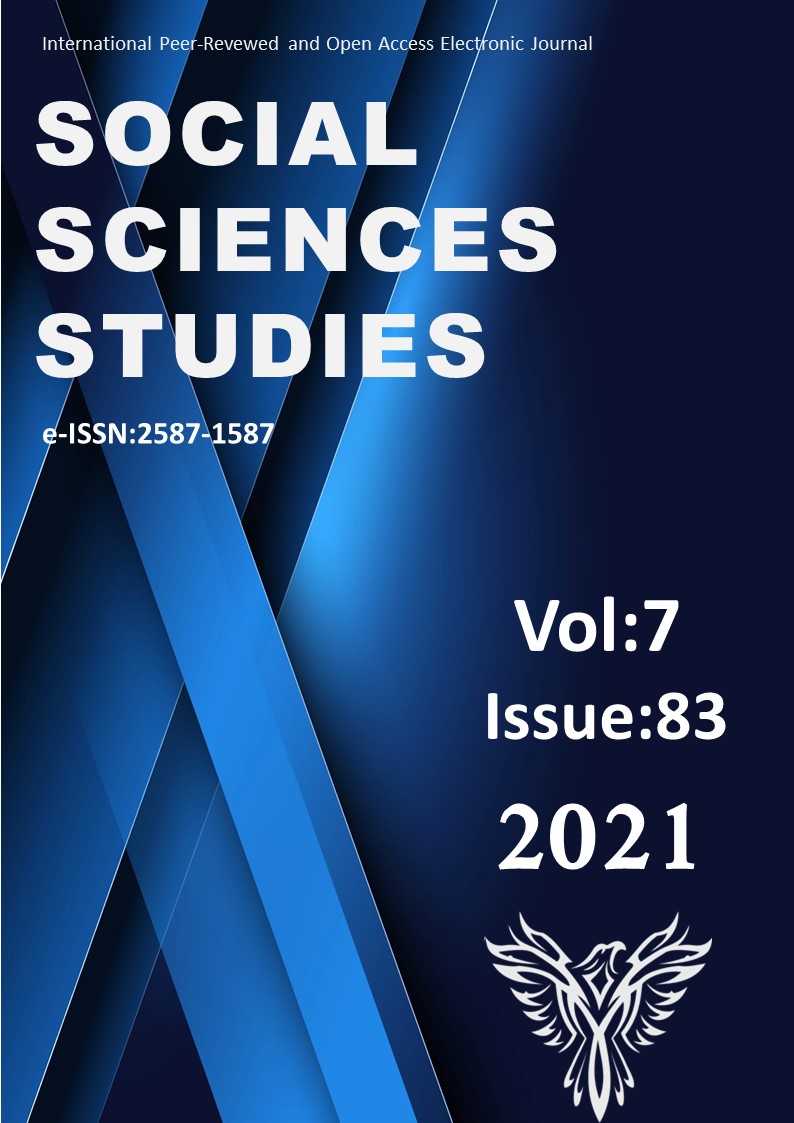Author :
Abstract
1960’lı yılların sanat hareketlerine bakıldığında disiplinler arası yaklaşımla sanat yapıtların üretildiği görülür. Disiplinler arası kavramı resim ve heykelin ötesinde üretim yapma düşüncesine denk gelir. Farklı disiplinlerin sanat alanına dâhil edilmesi ki bunlar; müzik, tiyatro, şiir, edebiyatın vb.dir. 1960’lı yıllar ve sonrası sanat üretimine dâhil edilen bu disiplinler kendi sanat dillerine ait yapıları da sanat yapıtının içine dâhil etmişlerdir. Bu yıllar çoklu sanat dillerinin bir aradalığıyla yeni malzeme ve anlatım dilleri arayışlarına olanaklar sağlamıştır. Bunun sonucunda, yeni olanaklar ile oluşturulan sanat yapıtlarının malzeme repertuvarı da oldukça değişmiş ve gelişmiştir. Resim ve heykel gibi geleneksel anlatım biçimleri terk edilince ortaya Yoksul sanat, Feminist sanat, Yeryüzü sanatı, Performans sanatı, Süreç sanatı, Fluxus gibi sanatsal hareketler ve bunlara bağlı olarak yeni anlatım dilleri de görünür olmuştur. Sanat hareketleri değiştikçe sanatçıların malzeme ve teknik yönelimleri de farklı mecralarda çeşitlenmiştir. Bu dönem sanat nesnesi malzeme ve tekniklerinin oldukça radikal hale geldiği noktası önemli bir noktadır. Özellikle de performans sanatında sanatçı kendi bedenini sanat nesnesi haline getirmiş ve bedeni üzerinde acı ve şiddeti deneyimleyerek görünür kılmıştır. Acının ve şiddetin görünürlüğü ve insan bedeninin sanat nesnesinin kendisini oluşturması; sanatçı, izleyici, galeri, müze ve sanat kavramlarını ters yüz etmiş ve yeniden tanımlanmalarını gerekli kılmıştır. Bunun da ötesinde kişisel ve toplumsal sorunlarla doğrudan ilişkilendirilebilen performans sanatında sanatçı yalnızca kendi bedenini sanat nesnesi alanına çevirmemiştir. Canlı ya da ölü hayvanı da sanat nesnesi olarak kullanmış; acı, şiddet ve ölümü hayvan üzerinde uygulamıştır. Hem kendisinin hem de izleyicinin dâhil olduğu performans ve yerleştirmelerde hayvanın öldürülmesine varan şiddette gösteriler oluşturmuştur. Bu bildiride hayvanın öldürüldüğü ya da ölümüne neden olunduğu performans sanatı yapıtları incelenerek sanatçı, yapıt ve izleyici açısından değerlendirmesi etik kavramı çerçevesinde çözümlenmeye çalışılacaktır.
Keywords
Abstract
Considering the art movements of the 1960s, it is seen that art works were produced with an interdisciplinary approach. The concept of interdisciplinary corresponds to the idea of producing beyond painting and sculpture. Including different disciplines in the field of art, which are; music, theater, poetry, literature, etc. These disciplines, which were included in the art production in the 1960s and after, included the structures of their own art languages into the art work. These years provided opportunities for the search for new material and expression languages with the combination of multiple arts languages. As a result, the material repertoire of the artworks created with new possibilities has changed and developed considerably. When traditional forms of expression such as painting and sculpture were abandoned, artistic movements such as Poor art, Feminist art, Earth art, Performance art, Process art, Fluxus and related new expression languages became visible. As the art movements change, the material and technical orientations of the artists have also diversified in different mediums. The point at which art object materials and techniques became quite radical during this period is an important point. Especially in performance art, the artist turned his body into an art object and made it visible by experiencing pain and violence on his body. The visibility of pain and violence and the human body's constitution of the object of art; it turned the concepts of artist, audience, gallery, museum and art upside down and required them to be redefined. Moreover, in performance art, which can be directly associated with personal and social problems, the artist has not only turned his body into the field of art object. He also used living or dead animals as an art object; He applied pain, violence and death on the animal. In the performances and installations both he and the audience were involved, he created demonstrations with violence up to the killing of the animal. In this paper, the performance art works in which the animal was killed or caused to die will be examined and the evaluation of the artist, artwork and audience will be analyzed within the framework of the concept of ethics.
Keywords
- Türk, A. (2021). “Sanat Nesnesi Olarak Hayvan Ve Etik” International Social Sciences Studies Journal, (e-ISSN:2587-1587) Vol:7,
- Issue:83; pp:2474-2481 SANAT NESNESİ OLARAK HAYVAN VE ETİK Animal And Ethics As Objects Of Art Doç. Ayşegül TÜRK Ankara Hacı Bayram Veli Üniversitesi Sanat ve Tasarım Fakültesi, Görsel Sanatlar Bölümü, Ankara/TÜRKİYE ORCID ID: https://orcid.org/0000-0001-7467-9456 ÖZET 1960’lı yılların sanat hareketlerine bakıldığında disiplinler arası yaklaşımla sanat yapıtların üretildiği görülür. Disiplinler arası kavramı resim ve heykelin ötesinde üretim yapma düşüncesine denk gelir. Farklı disiplinlerin sanat alanına dâhil edilmesi ki bunlar; müzik, tiyatro, şiir, edebiyatın vb.dir. 1960’lı yıllar ve sonrası sanat üretimine dâhil edilen bu disiplinler kendi sanat dillerine ait yapıları da sanat yapıtının içine dâhil etmişlerdir. Bu yıllar çoklu sanat dillerinin bir aradalığıyla yeni malzeme ve anlatım dilleri arayışlarına olanaklar sağlamıştır. Bunun sonucunda, yeni olanaklar ile oluşturulan sanat yapıtlarının malzeme repertuvarı da oldukça değişmiş ve gelişmiştir. Resim ve heykel gibi geleneksel anlatım biçimleri terk edilince ortaya Yoksul sanat, Feminist sanat, Yeryüzü sanatı, Performans sanatı, Süreç sanatı, Fluxus gibi sanatsal hareketler ve bunlara bağlı olarak yeni anlatım dilleri de görünür olmuştur. Sanat hareketleri değiştikçe sanatçıların malzeme ve teknik yönelimleri de farklı mecralarda çeşitlenmiştir. Bu dönem sanat nesnesi malzeme ve tekniklerinin oldukça radikal hale geldiği noktası önemli bir noktadır. Özellikle de performans sanatında sanatçı kendi bedenini sanat nesnesi haline getirmiş ve bedeni üzerinde acı ve şiddeti deneyimleyerek görünür kılmıştır. Acının ve şiddetin görünürlüğü ve insan bedeninin sanat nesnesinin kendisini oluşturması; sanatçı, izleyici, galeri, müze ve sanat kavramlarını ters yüz etmiş ve yeniden tanımlanmalarını gerekli kılmıştır. Bunun da ötesinde kişisel ve toplumsal sorunlarla doğrudan ilişkilendirilebilen performans sanatında sanatçı yalnızca kendi bedenini sanat nesnesi alanına çevirmemiştir. Canlı ya da ölü hayvanı da sanat nesnesi olarak kullanmış; acı, şiddet ve ölümü hayvan üzerinde uygulamıştır. Hem kendisinin hem de izleyicinin dâhil olduğu performans ve yerleştirmelerde hayvanın öldürülmesine varan şiddette gösteriler oluşturmuştur. Bu bildiride hayvanın öldürüldüğü ya da ölümüne neden olunduğu performans sanatı yapıtları incelenerek sanatçı, yapıt ve izleyici açısından değerlendirmesi etik kavramı çerçevesinde çözümlenmeye çalışılacaktır. Anahtar Kelimeler: Hayvan, Performans Sanatı, Sanat Nesnesi ABSTRACT





